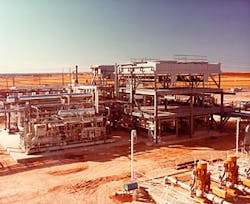EOR production tends to be long lived, partly because of advances in technology. For example, gas processing has changed in the SACROC Unit, Scurry County, Tex. Kinder Morgan CO2 Co. is the current operator of the SACROC, but initial operator Chevron Corp. began water-alternating-CO2 injection to enhance oil production from the unit in the 1970s.
Chevron initially installed a Benfield (hot potassium carbonate) process for removing CO2 in the returned gas while a refrigeration plant processed the remaining hydrocarbons into NGL and sales gas.
NATCO Group, which now operates the membrane units for SACROC, says that as production grew, the increase in CO2 in the returned gas outpaced the Benfield plant's capabilities. To avoid a major capital expansion to the Benfield plant, Chevron installed in 1983 membrane units to reduce the amount of CO2 in the produced gas.
The two membrane process plants, with 50 and 25 MMscfd capacities, respectively, reduced the CO2 content in the produced gas from 45-65% to about 30%, keeping the Benfield plant within process limitations, according to NATCO.
Production and membrane technology changes further altered the gas processing scheme. A membrane and pretreatment system, which replaced the Benfield plant, now handles up to 180 MMscfd of produced gas while lowering the CO2 content to 10% from 85%. Another change was the installation of a more efficient cryogenic plant and a small amine unit to replace the downstream refrigeration plant. This plant processes the gas stream containing 10% CO2 from the membrane into sales gas.
The processing plant can recover 150 MMscfd of CO2 for injection.
NATCO says the membrane units had been online 97.9% of time and were process ready for 99% of their nearly 20 years in service.
Cynara, now a part of NATCO Group, designed, built, owns, and operates the membrane CO2 removal facilities.
NATCO says a major concern with membranes is the economics associated with the service life of each membrane element. Failing elements could escalate operating costs. Cynara took on these operating risks and thereby proved a facility with less capital costs, according to the company.
In SACROC, NATCO reports that Cynara membrane element life can be more than 5 years with properly designed pretreatment. It says keys to SACROC's membrane success include:
- Careful feed-gas pretreatment with dehydration and temperature control.
- Stabilized operating conditions.
- Membrane element monitoring and modeling for optimizing element change-outs and minimizing process costs.
- Shared risks with the process facility provider.
- Collaboration between producer and process provider
- Cynara's hollow-fiber membrane being well suited for condensing hydrocarbon liquids.

